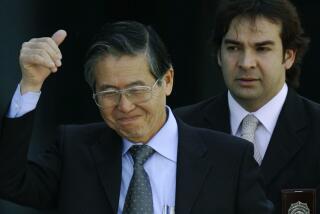Peruâs indigenous people win one round over developers
YURIMAGUAS, PERU â Peruvian tribal leader Luis Pizango says private investment in his part of the Amazon has brought only misery to him and his people.
Deforestation by loggers ruined tribal hunting grounds. An oil spill in the nearby Corrientes River diminished fishing. A 10,000-acre African palm plantation to produce biofuels displaced dozens of families. And a government plan to build a port facility on the Huallaga River to ease trade with Brazil stands to limit his peopleâs access to the waterway.
The Shawi indigenous people in northeastern Peru have many reasons for bitterness, Pizango, who is apu, or chief, of the group, said last week at a roadblock set up a few miles west of Yurimaguas to protest government policies.
âItâs been a long trajectory of abuse,â Pizango said. âWe got tired of it.â
He and others had blocked the main road leading to Peruâs interior with tree stumps and rocks and set up makeshift tents with plastic sheeting along the highway shoulders. The surrounding terrain of Loreto province was a rolling green moonscape that long ago had been clear-cut by loggers.
Then, in a development celebrated as a victory for indigenous groups, Peruâs Congress last week voted to revoke two laws enacted last year to further open the Amazon to mining, oil and timber development. The measures had enraged indigenous groups and led to a bloody confrontation June 5 in Bagua that officials said left 10 civilians and 23 police officers dead, with one officer missing and presumed dead.
Like Pizangoâs group, the indigenous people in Bagua were protesting decrees President Alan Garcia signed last year that gave foreign companies the right to take title to Amazonian land and facilitated their acquisition of road building rights of way. In addition to roadblocks, enraged tribes in the Amazon and in the Andean highlands closed an oil pipeline and took over two provincial airports after launching coordinated protests in early April.
The violence tarnished Peruâs image abroad and forced Peruvians to confront what some analysts described as indigenous peoplesâ second-class status in society and politics. Indigenous people represent about 5% to 25% of the population based on various estimates and largely consider themselves underrepresented in Congress.
Garcia, who signed the decrees without formal consultation with native groups, has been criticized for his handling of the matter.
âWeâve all learned a lot the last two weeks,â said economist and analyst Augusto Alvarez Rodrich. âEspecially the government. The Indians beat them by a knockout.â
Although Garcia initially blamed the Indians and unnamed foreign agitators for the killings, he since has been more conciliatory. Congress acted after Garcia went on national TV last week to acknowledge errors and âobstinacyâ and call for the two laws to be repealed.
Shortly after the June 18 vote, Peruâs largest indigenous umbrella group, known by its Spanish initials AIDESEP, called for all roadblocks to end. Many of the blockades, including Pizangoâs, were lifted by Friday afternoon, but unrest continued in some areas.
Although the government conceded points to the tribes, some of the groups said it would take more than the revocation of two laws to mollify them. Pizango said last week that his group wanted a half dozen other decrees revoked.
Prime Minister Yehude Simon, who has offered to resign, said the government may form a national commission to foster reconciliation.
âSadly, it seems to take violence for Peru to know itself, and weâve learned weâve made some big mistakes from not listening,â Simon said. âWe know we are very behind from where we should be, but the president is committed to making up for lost time.â
Richard Chase Smith, executive director of Common Good Foundation, a Lima-based group that promotes indigenous civil rights, said Peru lags far behind other Latin American nations.
âPeruvians have been forced to come face to face with the fact that indigenous are largely invisible, a condition that will take two or three more generations to fix,â Chase Smith said.
Since the Bagua incident, Garcia has come under intense criticism for, at best, insensitive rhetoric in reference to indigenous people before and after the deaths. He compared them to âgarden watchdogsâ who defend food, meaning Amazonian resources, that âthey donât eat nor let others eat.â
Garcia is taking additional heat for his support of foreign investment in mining, petroleum and timber as the key to Peruâs economic development. He described the laws that the indigenous object to, including the two that were revoked, as essential in meeting criteria for a bilateral free trade agreement with the U.S. that went into effect in January.
The president has insisted that facilitating foreign investment in the Amazon would bring order and formality to a region where illegal wood cutting and gold mining are rampant. He has also framed privatization of the Amazon as a means of fighting drug traffickers because it would add to the governmentâs presence.
Garciaâs push for dozens of decrees last year, many of them having to do with natural resources, has highlighted Indiansâ lack of participation in policy issues that affect them.
Pizango said the gulf separating the Garcia government and the indigenous community remains wide.
âWe are flexible. But we donât trust the government,â Pizango said. âIt has shown itâs ready to settle disputes by force and not through dialogue. And we have shown we will stand up for our rights.â
--
Kraul is a special correspondent.
More to Read
Sign up for Essential California
The most important California stories and recommendations in your inbox every morning.
You may occasionally receive promotional content from the Los Angeles Times.










